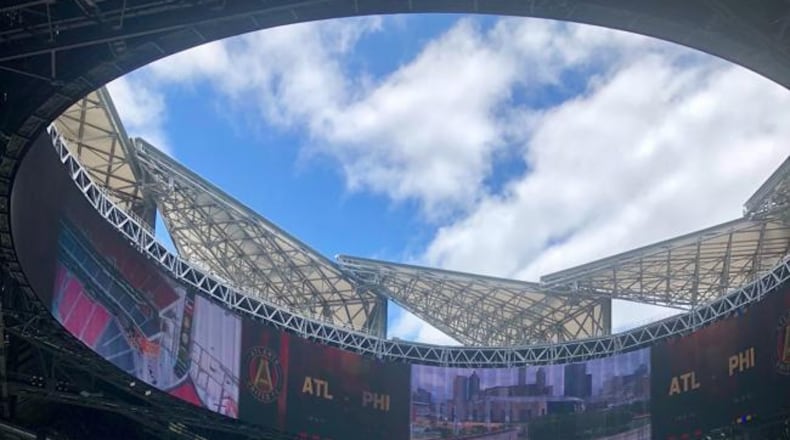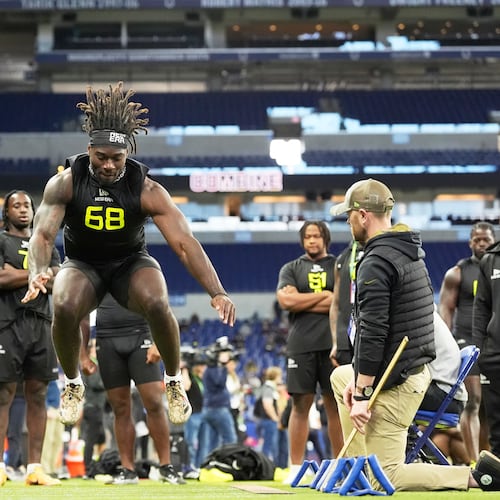Since the opening of Mercedes-Benz Stadium in 2017, the Falcons organization has publicly pegged the cost of the building at $1.5 billion.
But team owner Arthur Blank cites a higher number in a coming documentary he commissioned about the construction and impact of the stadium, saying near the film’s conclusion: “We ended up being close to $2 billion.”
Consider that a ballpark figure.
“I’m sure to Arthur it felt like $2 billion, but the actual, all-in, everything cost was a little bit south of $1.8 billion,” Mike Egan, the executive who oversaw the stadium project for Blank, said in an interview with The Atlanta Journal-Constitution this week. “It was between $1.75 billion and $1.8 billion.
“The $1.5 billion number that we always talked about was the actual hard construction cost to build the stadium. What we were not including in that is demolishing the Georgia Dome, building The Home Depot Backyard, the (stadium’s) art collection, the financing costs and other soft costs of the project. … We did not include the design fees in that $1.5 billion hard-cost number, so that’s probably the biggest single (difference).”
Egan, who is retiring at year’s end as senior vice president and general counsel of Falcons and Atlanta United parent company AMB Sports & Entertainment, said the total cost was a “moving target” that didn’t “settle out” until a couple of years after the stadium opened. Work on the retractable roof and ancillary projects continued for at least another 18 months after the first games in the stadium.
The two-hour documentary, “Rising Up: A Westside Story,” will premiere at 8 p.m. Monday on Georgia Public Broadcasting. The film tells the dual story of the stadium and of its troubled neighboring communities.
“Arthur commissioned this film well before the (stadium) project really got underway,” Egan said. “He wanted to document attempting to fulfill a couple of his dreams for the city of Atlanta, which were to build the greatest sports and entertainment complex in the world and to try to lift the Westside out of poverty and to make the benefits of the stadium expand across Northside Drive to the folks in those neighborhoods. He wanted to capture the effort and hoped that by coming out with this film it could be something that inspired others to think big dreams.”
The filmmaker, David Lewis Productions, had behind-the-scenes access throughout construction of the stadium. The documentary follows some of the community residents who found jobs through the stadium and the “Westside Works” program. It also includes footage from some tense and testy meetings of stadium construction leaders as they struggled with the complexity of the one-of-a-kind roof, seemingly endless complications, stressful schedule delays and an ever-rising price tag.
The stadium originally had a construction budget of $1 billion, which was increased to $1.2 billion and then to $1.4 billion and continued upward from there. The rising costs didn’t affect the amount of taxpayer money going into the project because Blank was responsible for cost overruns.
“Can we make the $1.4 (billion budget) at all? Do we have any chance?” Bill Darden, who was president of project manager Darden & Co., asked during one meeting shown in the film. “Can we make our deadline time-wise? Any chance?”
At another meeting captured on camera, Blank sternly told project leaders gathered around a conference table: “1.4 (billion) is your number. ... I am done going to the piggy-bank. We started at a billion, a billion two, a billion five. We got to crazy numbers. We all settled on this number, OK? I don’t want to hear any backsliding from anybody on the schedule or on the costs. I really don’t.”
“This is the most difficult project I’ve had to deliver,” Mac McCoy, who was director of operations for architecture firm HOK, said in the film. “It’s a very challenging project. It is a challenging client.”
Eventually, Blank and the construction team celebrated the opening of the stadium for the Falcons’ 2017 season.
“Has it taken years off my life? Only the Good Lord knows that, but I feel like it might have,” Darden said on camera. “It’s been an unbelievable grind, but we did it.”
Asked in the film what he would have done differently with the project, Falcons president and CEO Rich McKay said candidly: “Probably in the early design phase, fully understanding the impact of the roof structure. We just didn’t know what we were getting into. I did not have an appreciation for the fact that it had not only never been done, but it was not fully baked as an idea of how it was going to be executed.
“We did not understand that. It led to a lot of angst. It led to a lot of costs. It’s led to a spectacular building.”
About the Author
Keep Reading
The Latest
Featured



